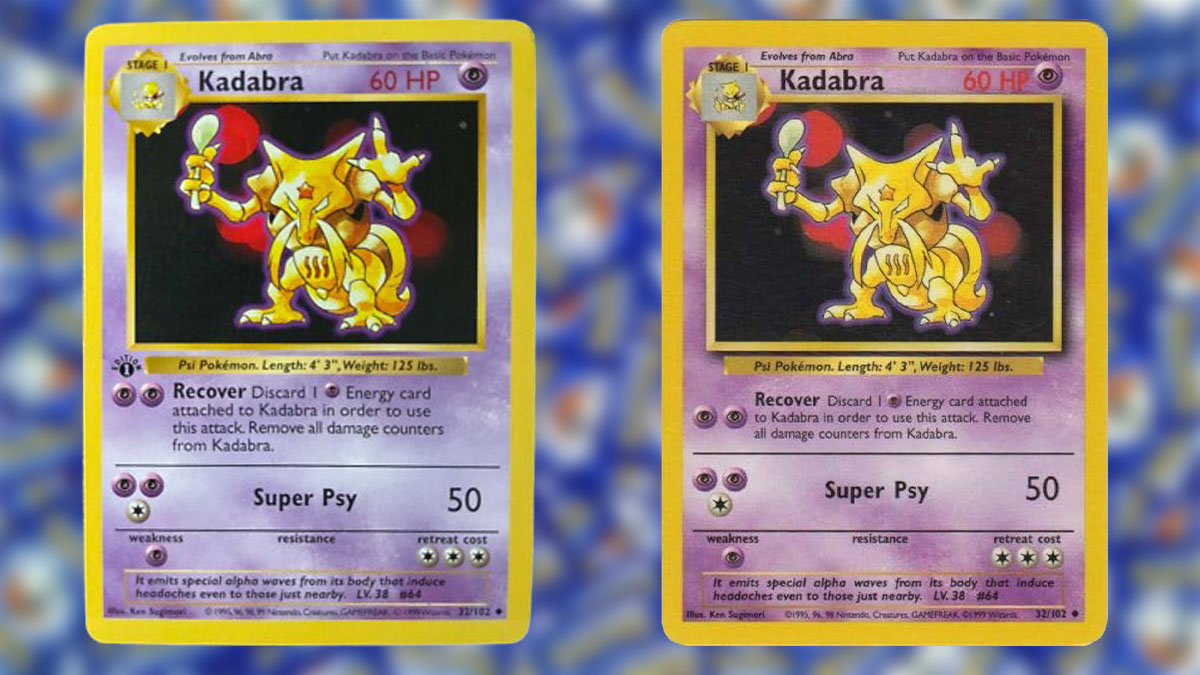In the vast world of Pokémon card collecting, there’s a fascinating game of spot-the-difference unfolding between shadowless and shadowed cards from the iconic Base Set of 1999. This subtle but crucial distinction is a key area of obsession for collectors and aficionados alike. Let’s delve into how these cards differ and why identifying between shadowless and shadowed prints can be such a rewarding treasure hunt.
The term “shadowless” might sound mystical, but in collector jargon, it simply describes early Pokémon cards with a design that features a flat, shadow-free frame around the artwork, creating a clean and simple aesthetic. No gray drop shadow languishes on the right side of the picture box; the layout uses thin, precise fonts that impart a sense of minimalism and nostalgia. But as more cards gushed forth from the printers, a change occurred — a shadow emerged. This shadow granted the card a sense of depth, a gentle mimicry of a 3D effect that came to define the more prevalent Unlimited prints. This seemingly small and artistic tweak etched a lasting line between two different printings and instilled a striking hierarchy in the eyes of collectors.
To understand the chronology: it all began with the First Edition cards. These bear the proud “First Edition” stamp and were the inaugural specimens in the Pokémon TCG lineage. They laid the groundwork with the shadowless template and were followed closely by the unmarked, shadowless Base Set cards. Soon after, vast reams of shadowed Unlimited cards flooded the market. These were the packs most of us eagerly tore open in childhood, creating fond memories and overflowing collections across the globe.
But what alchemy gives the shadowless cohort its allure? To put it succinctly: scarcity. The shadowless cards, mint and undisturbed, are fewer in number than their shadowed companions and more ubiquitous than the First Editions, placing their worth somewhere comfortably in between. This increased worth is mostly obvious in the sought-after holos or familiar faces like Charizard, Blastoise, and Venusaur. It’s these subtle differences that can propel a card’s value skyward in the blink of an eye.
Now, how do we recognize these famed shadowless beauties at a quick glance? Allow the act of visual comparison to serve as your guide:
1. **Picture Frame:** A shadowless card presents a straightforward flat frame, distinctly lacking the shadowed elevation that characterizes its Unlimited counterparts.
2. **HP and Font Weight:** Focus on the HP indicator atop the card. A shadowless specimen will boast thinner red text with a tightly-knit numeral and HP abbreviation. By contrast, an Unlimited card’s HP appears bold, assertively spaced, bolder in demeanor.
3. **Border and Ink Hue:** There is an almost imperceptible elegance to the shadowless card’s slightly paler yellow border and gentler ink saturation. Not stark, but a sensation that whispers rather than shouts when encountered in person.
4. **Typography in Stage Box and Attacks:** Shadowless cards often retain finer, slimmer lines within their Stage box and attack sections. The letters breathe quietly, unlike their more robust Unlimited forebears.
5. **Legalese, aka the Copyright Line:** Notice the early era’s denser, multi-part Nintendo, Creatures, GAMEFREAK verbiage on the shadowless printing. Small yet impactful spacing and layout tweaks distinguish Unlimited editions.
For those keen to deepen their collection, maintaining these tips atop your memory can transform an idle afternoon with a childhood binder into a thrilling hunt. The more frequently you compare a shadowless card against its shadowed kin, the quicker distinctions pop into relief.
Collectors often pitch their tent within the realm of First Edition Base as the holy grail of rarity and value. The shadowless Base Set acts as a compelling heir apparent, with premium prices trailing closely behind for prized cards. Unlimited, while abundant and nostalgic, represents a more common tier, though retain significant worth when encapsulated in mint-grade quality, especially for marquee characters like the ubiquitous Charizard.
As you begin sorting, ensure you lookout for those missing shadows along the artwork’s right margin — a hint that what you hold could be a collectible that commands respect and perhaps envy from peers and fellow enthusiasts. Pieces may start falling into logical order as you decipher their aesthetic differences, and the once-daunting landscape of trading card taxonomy can become an inviting tableau for your eye to wander.
